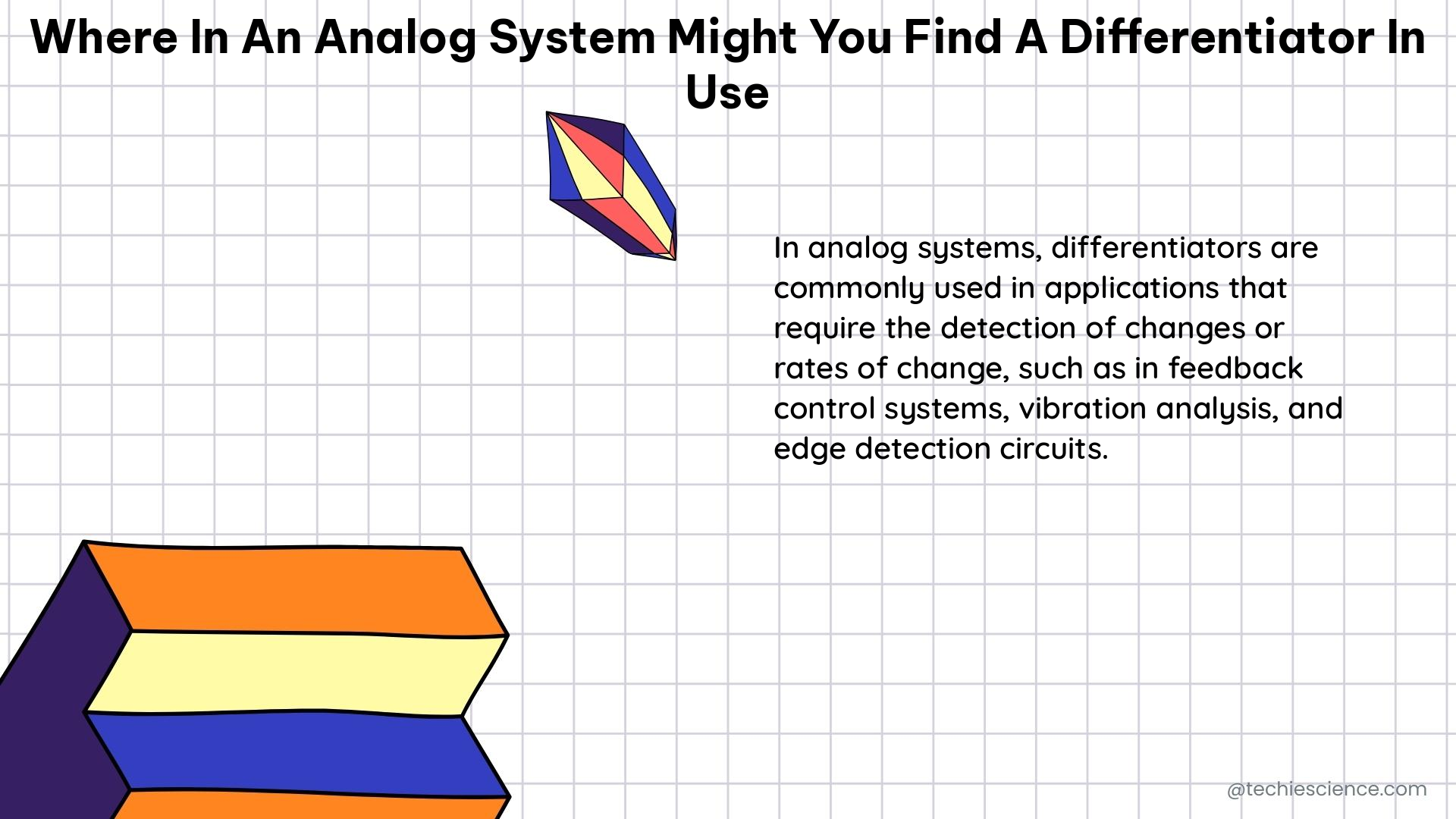A differentiator is a crucial component in analog systems, used to measure the rate of change of an input signal over time. This circuit, typically built using operational amplifiers (op-amps), plays a vital role in various applications, from analog computers and process instrumentation to signal conditioning and meta-programmable analog systems. In this comprehensive blog post, we’ll explore the diverse use cases of differentiators in analog systems, delving into the technical details and quantifiable data that make them indispensable.
Differentiators in Analog Computers
In analog computers, differentiators are employed to perform differentiation operations on input analog voltages. This functionality is crucial for solving differential equations, a fundamental task in many scientific and engineering applications. The op-amp-based differentiator circuit can be designed to have a gain of up to 100 dB, ensuring accurate and responsive differentiation of the input signal.
For example, in an analog computer used for simulating the motion of a pendulum, the differentiator would be used to calculate the rate of change of the pendulum’s angle with respect to time. This information is then used to update the position and velocity of the pendulum in the simulation, allowing for real-time modeling of the system’s dynamics.
Differentiators in Process Instrumentation

In process instrumentation, differentiators are employed to monitor the rate of change of various process variables, such as pressure, temperature, or flow rate. By monitoring the rate of change, engineers can detect abnormal conditions or impending failures more quickly, enabling proactive maintenance and optimization of the process.
Consider a scenario where a differentiator is used to monitor the flow rate in a chemical processing plant. If the flow rate suddenly increases beyond a predetermined threshold, the differentiator circuit can generate an output voltage that triggers an alarm or warning system. This early detection can help prevent equipment damage, product quality issues, or even safety hazards.
The gain and bandwidth of the differentiator circuit in process instrumentation applications are typically tailored to the specific process dynamics and noise levels. For instance, a differentiator with a bandwidth of 1 kHz and a gain of 50 dB might be suitable for monitoring the flow rate in a fast-moving industrial process, while a differentiator with a lower bandwidth and gain might be more appropriate for a slower, more stable process.
Differentiators in Signal Conditioning
Differentiators also find applications in signal conditioning, where they are used to transform waveforms and prepare signals for further processing. In this context, the differentiator’s ability to extract the rate of change of the input signal is particularly valuable.
One example is the use of differentiators in vibration analysis systems. By differentiating the input signal from an accelerometer, the system can obtain the velocity and displacement of the vibrating object, providing valuable insights into the mechanical behavior of the system.
The gain and bandwidth of the differentiator circuit in signal conditioning applications are critical parameters that must be carefully selected to balance the desired signal transformation with the need to minimize noise and instability. Typically, differentiators in signal conditioning have a high gain at high frequencies and a low gain at low frequencies, with additional components added to provide high-frequency roll-off and improve the circuit’s stability.
Differentiators in Meta-Programmable Analog Systems
The versatility of differentiators extends to meta-programmable analog systems, which are designed to adapt to the incident signal and can be used to implement analog solvers of differential equations. In these systems, differentiators play a pivotal role in the analog computation of derivatives, a fundamental operation in solving differential equations.
The meta-programmable nature of these systems allows for the reconfiguration of the differentiator circuit parameters, such as gain and bandwidth, to optimize the performance for specific applications. This flexibility makes differentiators an essential component in the development of analog solvers that can adapt to a wide range of differential equations encountered in various scientific and engineering domains.
The quantifiable characteristics of differentiators in meta-programmable analog systems include the circuit’s gain, which can be tuned over a wide range to accommodate different input signal amplitudes, and the bandwidth, which determines the range of frequencies over which the differentiator can accurately operate. These parameters are crucial in ensuring the reliable and efficient analog computation of derivatives within the meta-programmable analog system.
Conclusion
Differentiators are ubiquitous in analog systems, serving as critical components in a wide range of applications, from analog computers and process instrumentation to signal conditioning and meta-programmable analog systems. By understanding the technical details and quantifiable characteristics of differentiators, engineers can design and optimize these circuits to meet the specific requirements of their analog systems, unlocking the full potential of these versatile and indispensable devices.
References:
1. ANALOG SYSTEMS AND APPLICATIONS: Differentiator – YouTube. (2023-02-20). Retrieved from https://www.youtube.com/watch?v=mRVle-RgeZU
2. Practical Analog Semiconductor Circuits – Computational Circuits. (n.d.). Retrieved from https://ecstudiosystems.com/discover/textbooks/lessons/semiconductors/chapter9-7-computational-circuits/
3. Differentiators. (n.d.). Retrieved from https://hasler.ece.gatech.edu/Courses/ECE6435/Unit2/Chapter10.pdf
4. Operational Amplifier Differentiator Circuit – Electronics Notes. (n.d.). Retrieved from https://www.electronics-notes.com/articles/analogue_circuits/operational-amplifier-op-amp/analogue-differentiator-circuit.php
5. Meta-programmable analog differentiator | Nature Communications. (2022-03-31). Retrieved from https://www.nature.com/articles/s41467-022-29354-w

The lambdageeks.com Core SME Team is a group of experienced subject matter experts from diverse scientific and technical fields including Physics, Chemistry, Technology,Electronics & Electrical Engineering, Automotive, Mechanical Engineering. Our team collaborates to create high-quality, well-researched articles on a wide range of science and technology topics for the lambdageeks.com website.
All Our Senior SME are having more than 7 Years of experience in the respective fields . They are either Working Industry Professionals or assocaited With different Universities. Refer Our Authors Page to get to know About our Core SMEs.